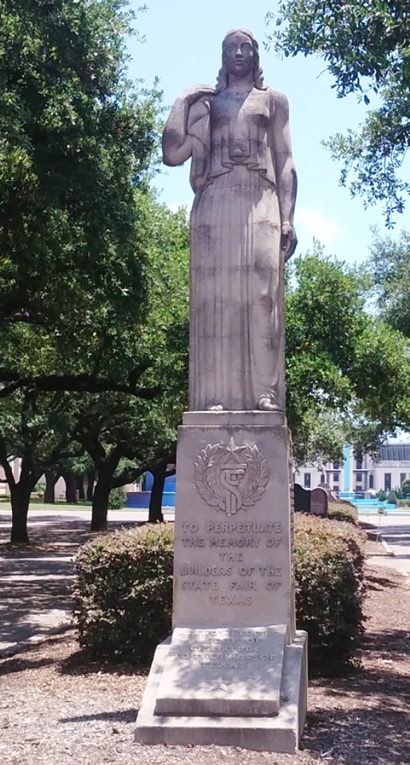|
Beyond
the tall, black gate is an area that combines elements of a plaza
and a small boulevard. After having no name for many decades, the
section was called the Grand Plaza in preparation for the Centennial
Exposition. Two years later in 1938, it was renamed Frank P. Holland
Court as a tribute to the man who first envisioned a state fair
for the city. He also served as the mayor for Dallas
in 1893.
On the left side of this shaded area, a bike station allows visitors
to rent a bike by the half hour. The price is five dollars for the
first thirty minutes, $2.50 for each additional thirty minutes,
and fifty dollars for the entire day. Allowing riders to return
the bicycles by eleven at night, the self-service station requires
the use of a credit card. However. the service cannot be used during
the state fair.
The centerpiece of Frank P. Holland Court is the Founders Statue.
Made of concrete, the sculpture depicts a female figure. Beneath
it, tribute is made to those who signed the charter to make the
state fair a reality, the fair presidents from 1886 to 1938, and
the Press of Texas. While the founders and presidents are listed
on the sides of a column, the recognition of the newspapers for
their role in publicizing the fair is put on the base.
|
 |
Fair Park - Founders
Statue by Raoul Josset
Photo courtesy Clint Skinner, February 2016 |
|
The statue's
dedication took place on October 8, 1938 on the opening day of the
fair's fiftieth anniversary. The golden birthday would have taken
place two years earlier, but the Texas
Centennial and Pan Am Exposition forced a postponement of the
celebration. The unveiling of the statue, performed by former fair
president J. J. Eckford, was witnessed by descendants of the founding
members. During the ceremony, the front headlines of three hundred
newspapers were placed inside an iron crypt located at the base
of the statue. An official from the Texas Press Association then
received the key to the crypt so it could be reopened fifty years
later. Unfortunately, the compartment was poorly sealed, causing
the papers to turn to dust when touched.
Raoul Josset designed
the Founders Statue and Joseph Martin made it. The two Frenchmen
were two of the main artists who helped theme the exposition. Born
in the village of Miery, Martin left school at the age of eleven
and trained to be a wood carver under the guidance of his father.
However, Martin changed his mind when he discovered that he enjoyed
sculpting stone more than wood. He enrolled at an art school in
Paris, but his education was interrupted by World
War I. Martin never returned to school, but instead worked as
a sculptor for designers Louis Sue and André Mare. In 1920, he became
close friends with Raoul
Josset.
Josset was born in
the city of Tours. Although his father was doctor, he decided to
pursue a career as a sculptor. Josset
was successful in his academic endeavor and had his own studio.
His work was interrupted when he volunteered as an interpreter to
communicate with the American forces stationed in France. From 1920
to 1926, he made war memorials throughout the country. All went
well until France entered an economic depression in 1926, which
resulted in Josset
deciding to escape to America for a better opportunity.
Martin left for America two years later. He arrived in Chicago but
moved to Cleveland in 1931, where he worked for a company alongside
his friend Josset.
The Great Depression forced the duo to move back to Chicago where
they were hired to make sculptures for the 1933 Century of Progress
Exposition. This resulted in the pair's employment to help with
the Texas Centennial.
September 4, 2016
© Clint
Skinner
|
References:
1.Bigtex.com
2.Dallashistory.org
3.Dallas Morning News Archives
4.Fairpark.org
5.Slate, John H. Historic Dallas Parks. Arcadia Publishing, 2010.
6.Tshaonline.org
7.Watermelon-kid.com
8.Wikipedia.org
8.Winters, Willis Cecil. Fair Park. Arcadia Publishing, 2010. |
|
|
| Texas
Escapes, in its purpose to preserve historic, endangered and vanishing
Texas, asks that anyone wishing to share their local history, stories,
landmarks and vintage or recent photos, please contact
us. |
|
|
